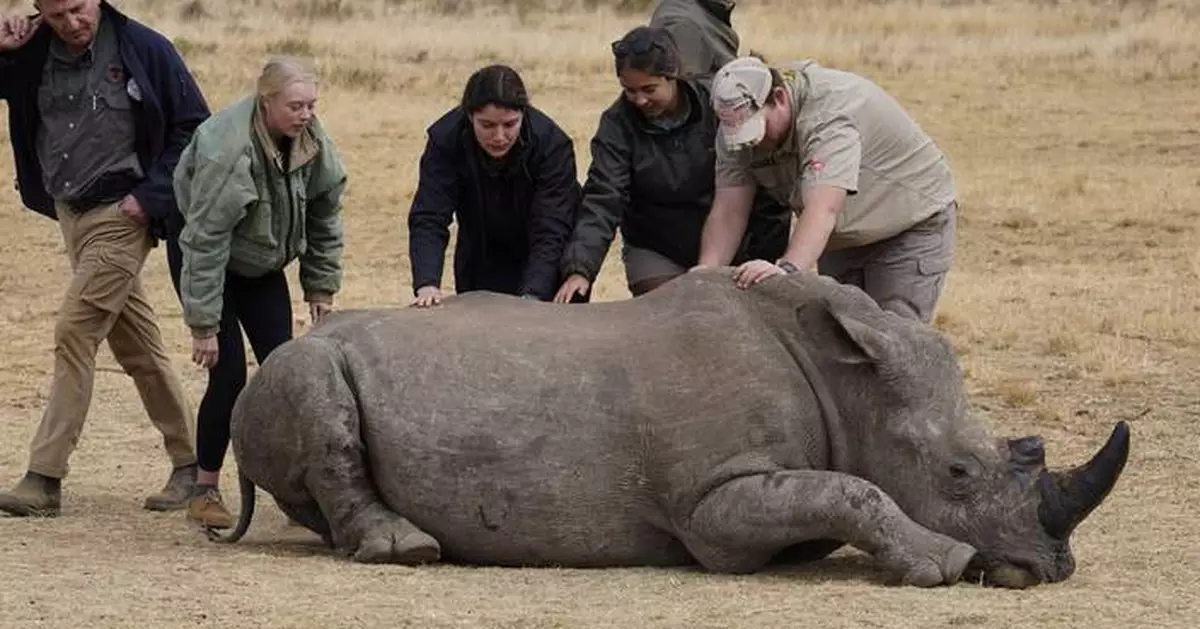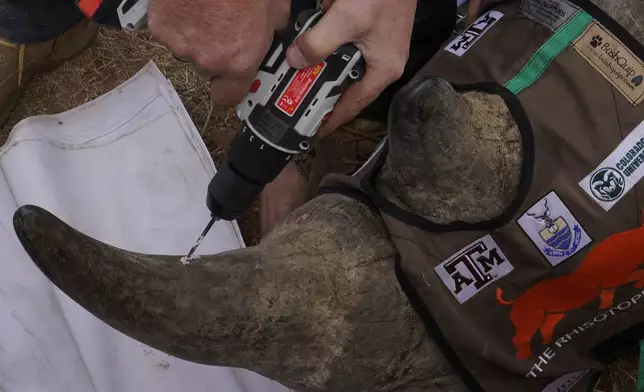MOKOPANE, South Africa (AP) — Researchers in South Africa have injected radioactive material into the horns of 20 rhinos as part of a research project aimed at reducing poaching.
The idea is that radiation detectors already in place at national borders would detect the horns and help authorities arrest poachers and traffickers.
Click to Gallery
MOKOPANE, South Africa (AP) — Researchers in South Africa have injected radioactive material into the horns of 20 rhinos as part of a research project aimed at reducing poaching.
A sedated rhino is prepared to be tranquilized, before a hole is drilled into its horn and isotopes carefully inserted, at a rhino orphanage in the country's northern province of Limpopo, Tuesday, June 25, 2024. Researchers have started the final phase of a research project aimed at reducing rhino poaching by inserting radioisotopes into rhino horns to devalue one of the most highly trafficked wildlife commodities. (AP Photo/Denis Farrell)
A rhino, front, recovers from a tranquilizer, after a hole was drilled into its horn and isotopes carefully inserted, at a rhino orphanage in the country's northern province of Limpopo, Tuesday, June 25, 2024. Researchers have started the final phase of a research project aimed at reducing rhino poaching by inserting radioisotopes into rhino horns to devalue one of the most highly trafficked wildlife commodities. (AP Photo/Denis Farrell)
A rhino recovers from a tranquilizer, after a hole was drilled into its horn and isotopes carefully inserted, at a rhino orphanage in the country's northern province of Limpopo, Tuesday, June 25, 2024. Researchers have started the final phase of a research project aimed at reducing rhino poaching by inserting radioisotopes into rhino horns to devalue one of the most highly trafficked wildlife commodities. (AP Photo/Denis Farrell)
Professor James Larkin performs a procedure where isotopes are placed into a rhino's at a rhino orphanage in the country's northern province of Limpopo, Tuesday, June 25, 2024. Researchers have started the final phase of a research project aimed at reducing rhino poaching by inserting radioisotopes into rhino horns to devalue one of the most highly trafficked wildlife commodities. (AP Photo/Denis Farrell)
Professor James Larkin drills a hole into a rhinos horn to insert isotopes at a rhino orphanage in the country's northern province of Limpopo, Tuesday, June 25, 2024. Researchers have started the final phase of a research project aimed at reducing rhino poaching by inserting radioisotopes into rhino horns to devalue one of the most highly trafficked wildlife commodities. (AP Photo/Denis Farrell)
Professor James Larkin drills a hole into a rhinos horn to insert isotopes at a rhino orphanage in the country's northern province of Limpopo, Tuesday, June 25, 2024. Researchers have started the final phase of a research project aimed at reducing rhino poaching by inserting radioisotopes into rhino horns to devalue one of the most highly trafficked wildlife commodities. (AP Photo/Denis Farrell)
A sedated rhino is prepared to be tranquilized, before a hole is drilled into its horn and isotopes carefully inserted, at a rhino orphanage in the country's northern province of Limpopo, Tuesday, June 25, 2024. Researchers have started the final phase of a research project aimed at reducing rhino poaching by inserting radioisotopes into rhino horns to devalue one of the most highly trafficked wildlife commodities. (AP Photo/Denis Farrell)
A sedated rhino is prepared to be tranquilized, before a hole is drilled into its horn and isotopes carefully inserted, at a rhino orphanage in the country's northern province of Limpopo, Tuesday, June 25, 2024. Researchers have started the final phase of a research project aimed at reducing rhino poaching by inserting radioisotopes into rhino horns to devalue one of the most highly trafficked wildlife commodities. (AP Photo/Denis Farrell)
The research, which has included the participation of veterinarians and nuclear experts, begins with the animal being tranquilized before a hole is drilled into its horn and the nuclear material carefully inserted. This week, researchers at the University of the Witwatersrand 's Radiation and Health Physics Unit in South Africa injected 20 live rhinos with these isotopes. They hope the process can be replicated to save other wild species vulnerable to poaching — like elephants and pangolins.
“We are doing this because it makes it significantly easier to intercept these horns as they are being trafficked over international borders, because there is a global network of radiation monitors that have been designed to prevent nuclear terrorism," said Professor James Larkin, who heads the project. "And we’re piggybacking on the back of that.”
According to figures by the International Union for Conservation of Nature, an international conservation body, the global rhino population stood at around 500,000 at the beginning of the 20th century. It now stands at around 27,000 due to continued demand for rhino horns on the black market.
South Africa has the largest population of rhinos with an estimated 16,000, making it a hotspot with over 500 rhinos killed yearly.
The country experienced a significant decline in rhino poaching around 2020 at the height of the COVID-19 pandemic, but the numbers increased when virus lockdown restrictions were eased.
“We’ve got to do something new and something different to reduce poaching. You know, you’ll see the figures they’ve already started going up," said Larkin. "During Covid, they all went down but post Covid we are now starting to see those numbers go up again.”
While the idea has received support from some in the industry, the researchers have had to jump many ethical hurdles posed by critics of their methodology.
Pelham Jones, chairperson of the Private Rhino Owners Association, is among the critics of the proposed method and doubts that it would effectively deter poachers and traffickers.
“(Poachers) have worked out other ways of moving rhino horn out of the country, out of the continent or off the continent, not through traditional border crossings," he said. "They bypass the border crossings because they know that is the area of the highest risk of confiscation or interception.”
Professor Nithaya Chetty, dean of the science faculty at Witwatersrand, said the dosage of the radioactivity is very low and its potential negative impact on the animal was tested extensively.
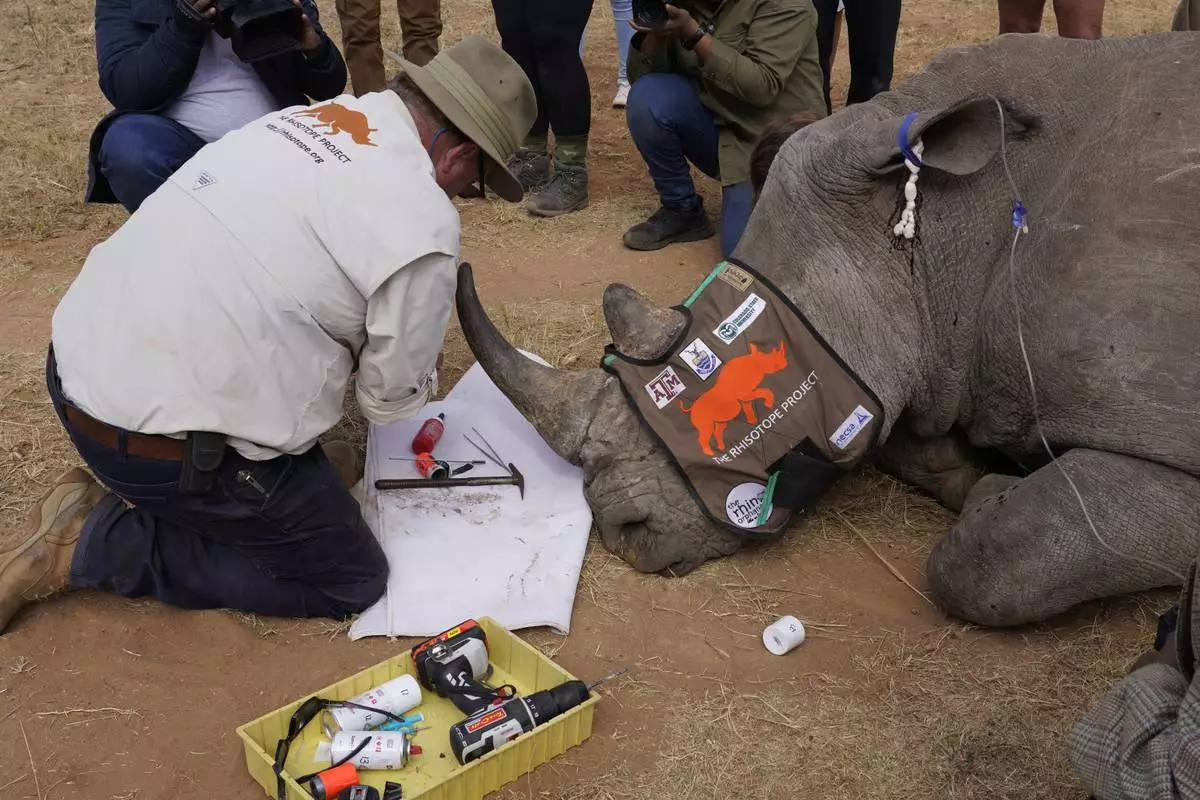
Professor James Larkin performs a procedure where isotopes are placed into a rhino's at a rhino orphanage in the country's northern province of Limpopo, Tuesday, June 25, 2024. Researchers have started the final phase of a research project aimed at reducing rhino poaching by inserting radioisotopes into rhino horns to devalue one of the most highly trafficked wildlife commodities. (AP Photo/Denis Farrell)
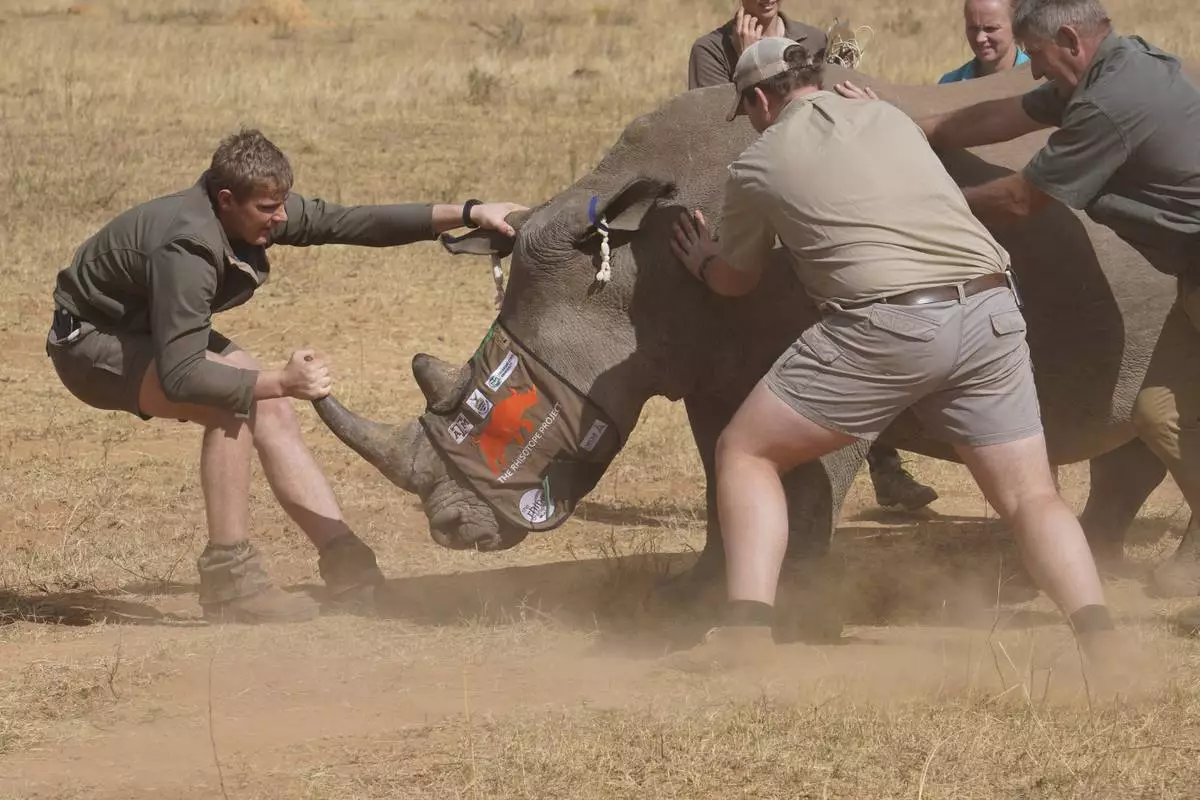
A sedated rhino is prepared to be tranquilized, before a hole is drilled into its horn and isotopes carefully inserted, at a rhino orphanage in the country's northern province of Limpopo, Tuesday, June 25, 2024. Researchers have started the final phase of a research project aimed at reducing rhino poaching by inserting radioisotopes into rhino horns to devalue one of the most highly trafficked wildlife commodities. (AP Photo/Denis Farrell)
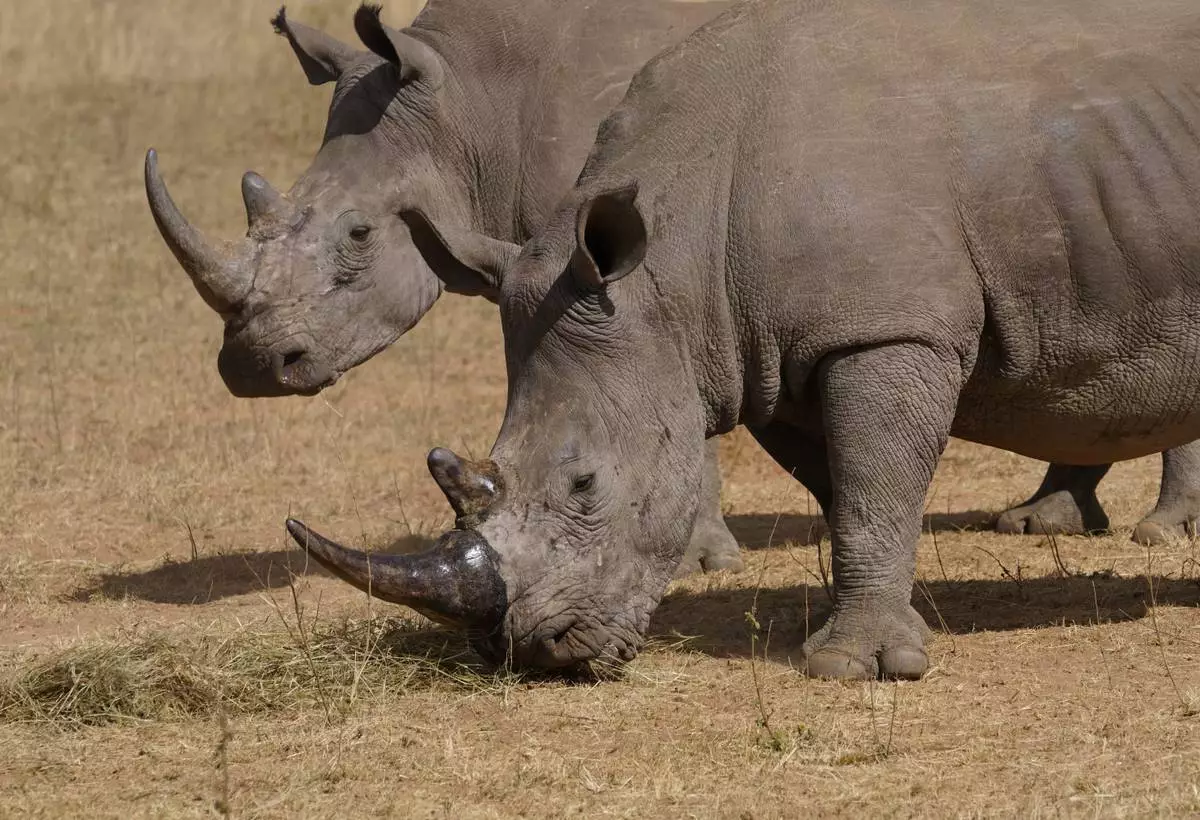
A rhino, front, recovers from a tranquilizer, after a hole was drilled into its horn and isotopes carefully inserted, at a rhino orphanage in the country's northern province of Limpopo, Tuesday, June 25, 2024. Researchers have started the final phase of a research project aimed at reducing rhino poaching by inserting radioisotopes into rhino horns to devalue one of the most highly trafficked wildlife commodities. (AP Photo/Denis Farrell)
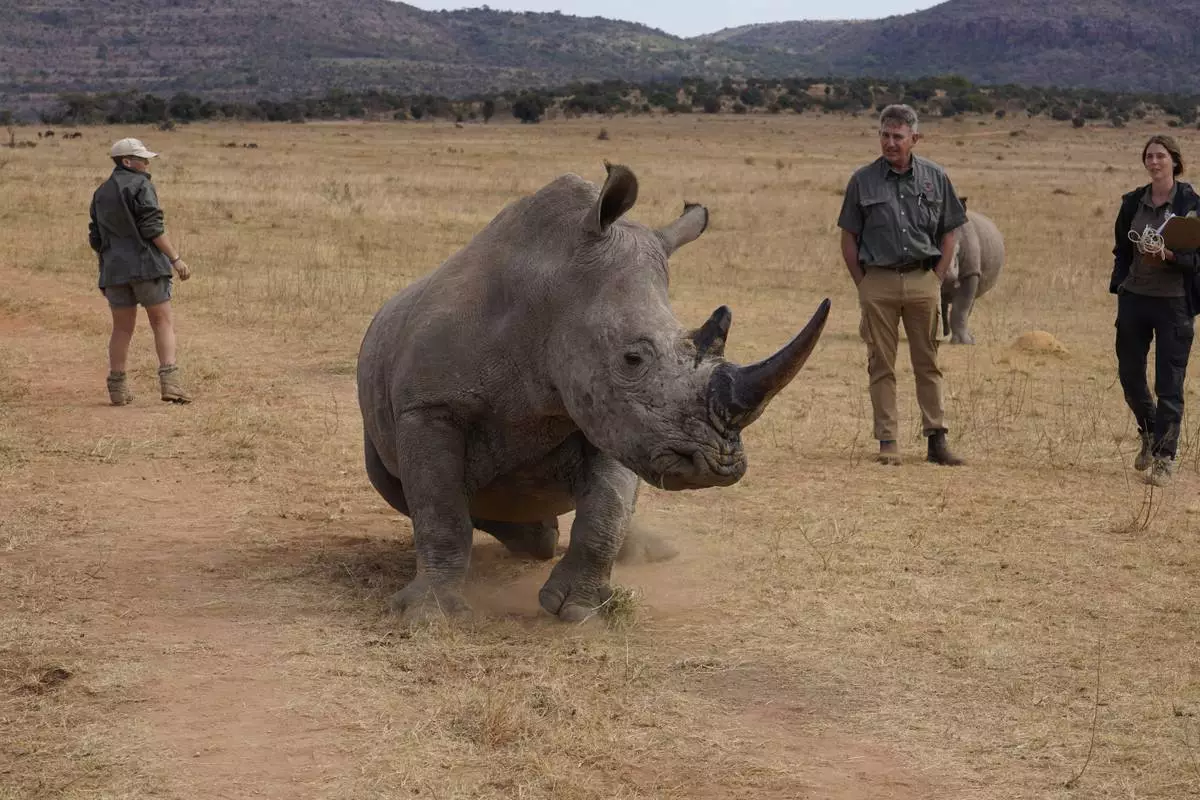
A rhino recovers from a tranquilizer, after a hole was drilled into its horn and isotopes carefully inserted, at a rhino orphanage in the country's northern province of Limpopo, Tuesday, June 25, 2024. Researchers have started the final phase of a research project aimed at reducing rhino poaching by inserting radioisotopes into rhino horns to devalue one of the most highly trafficked wildlife commodities. (AP Photo/Denis Farrell)
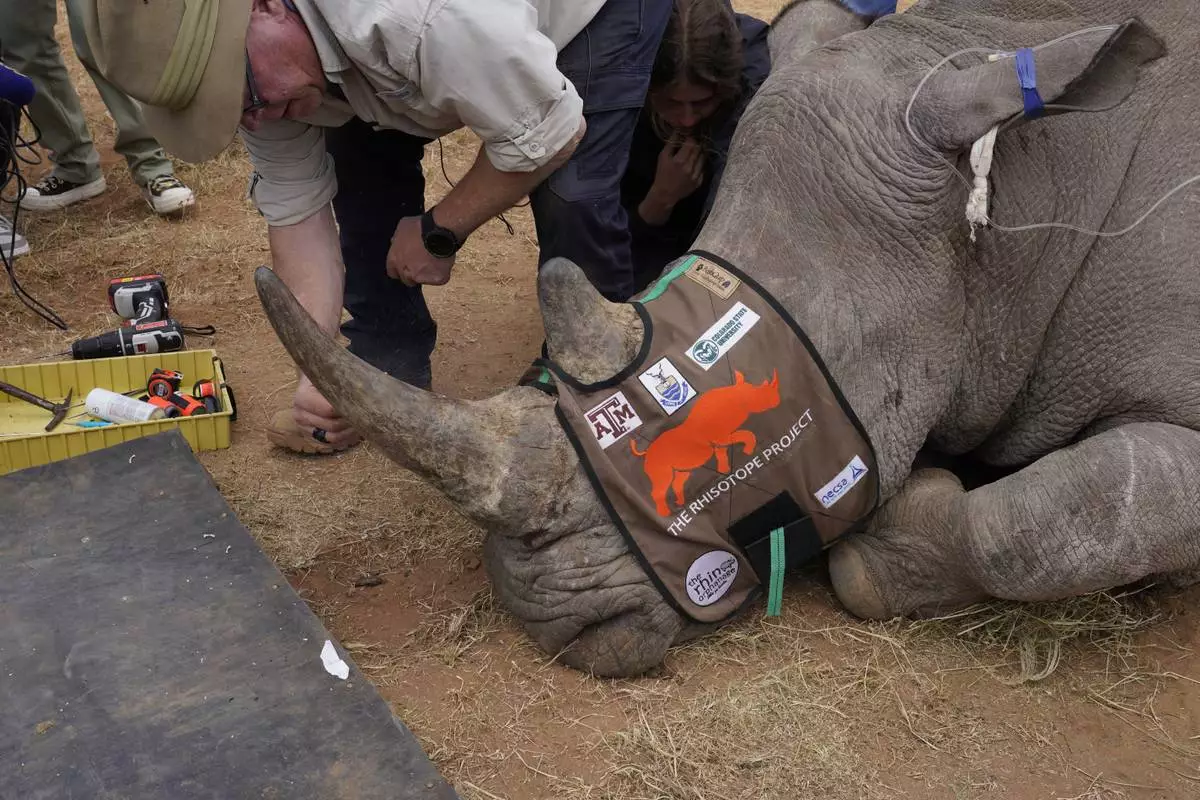
Professor James Larkin performs a procedure where isotopes are placed into a rhino's at a rhino orphanage in the country's northern province of Limpopo, Tuesday, June 25, 2024. Researchers have started the final phase of a research project aimed at reducing rhino poaching by inserting radioisotopes into rhino horns to devalue one of the most highly trafficked wildlife commodities. (AP Photo/Denis Farrell)

Professor James Larkin drills a hole into a rhinos horn to insert isotopes at a rhino orphanage in the country's northern province of Limpopo, Tuesday, June 25, 2024. Researchers have started the final phase of a research project aimed at reducing rhino poaching by inserting radioisotopes into rhino horns to devalue one of the most highly trafficked wildlife commodities. (AP Photo/Denis Farrell)
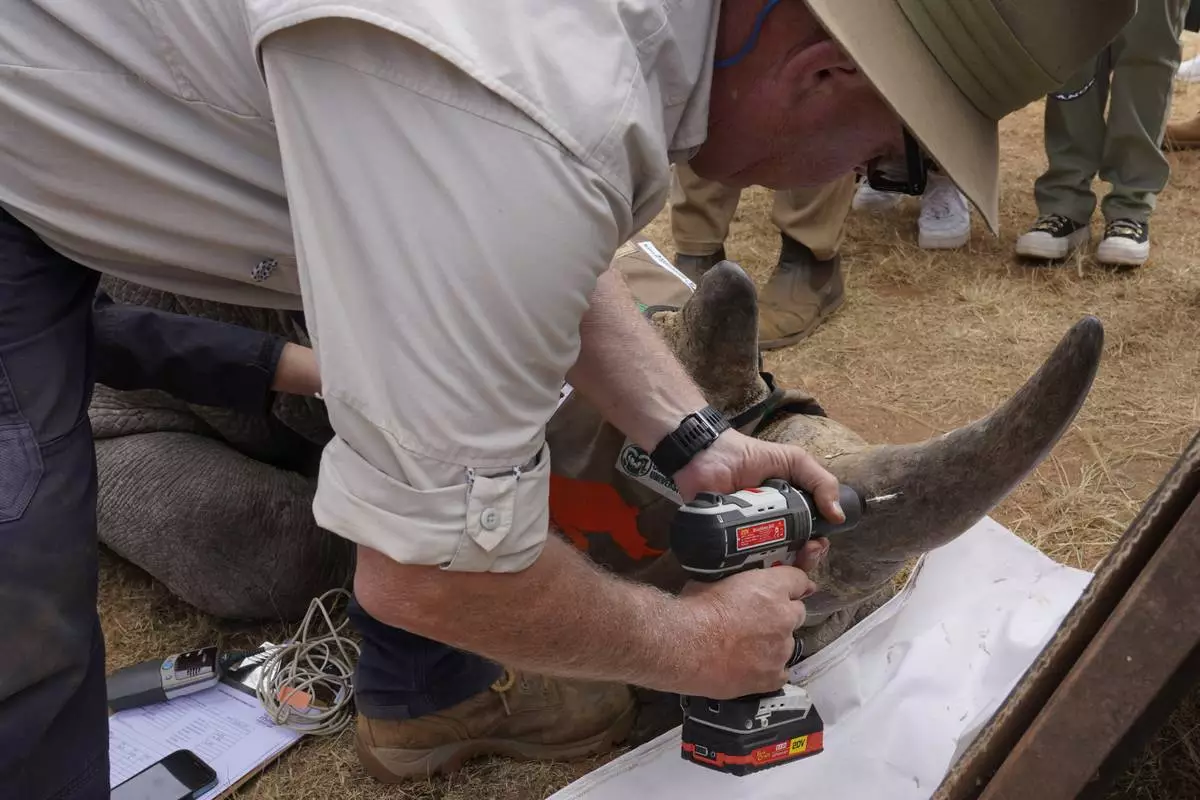
Professor James Larkin drills a hole into a rhinos horn to insert isotopes at a rhino orphanage in the country's northern province of Limpopo, Tuesday, June 25, 2024. Researchers have started the final phase of a research project aimed at reducing rhino poaching by inserting radioisotopes into rhino horns to devalue one of the most highly trafficked wildlife commodities. (AP Photo/Denis Farrell)
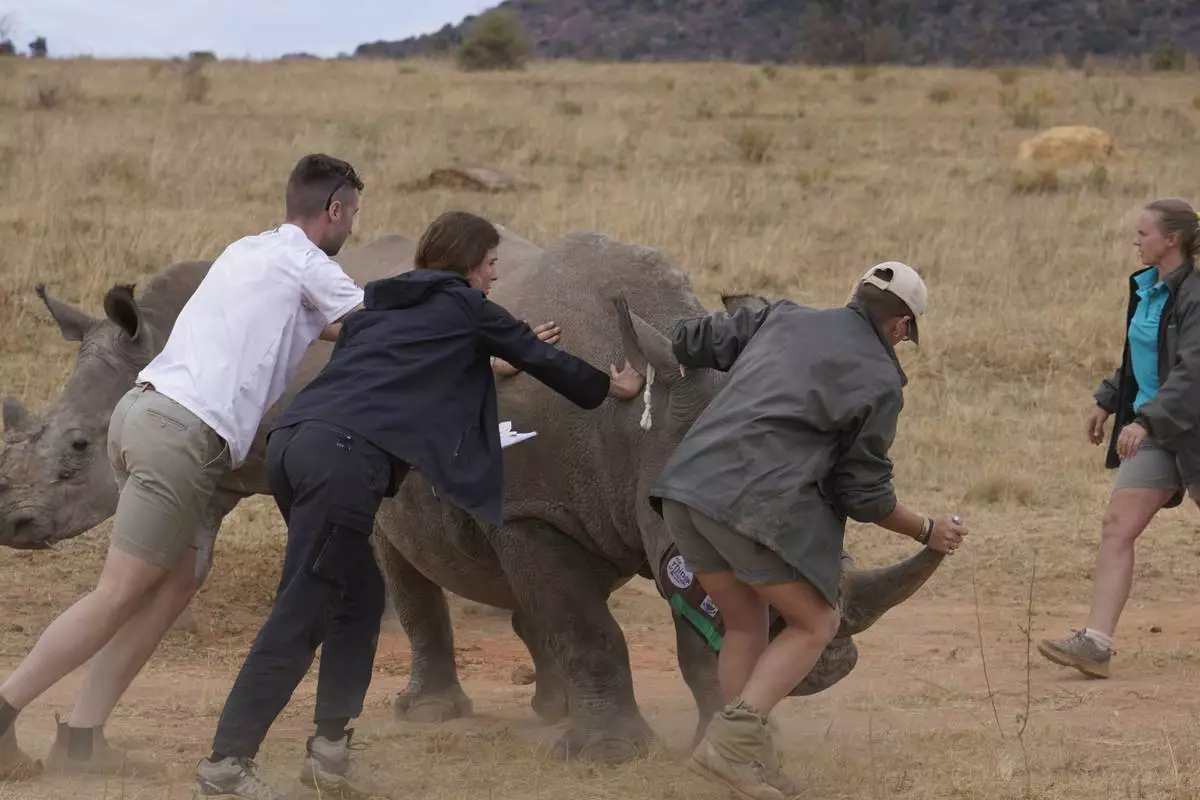
A sedated rhino is prepared to be tranquilized, before a hole is drilled into its horn and isotopes carefully inserted, at a rhino orphanage in the country's northern province of Limpopo, Tuesday, June 25, 2024. Researchers have started the final phase of a research project aimed at reducing rhino poaching by inserting radioisotopes into rhino horns to devalue one of the most highly trafficked wildlife commodities. (AP Photo/Denis Farrell)
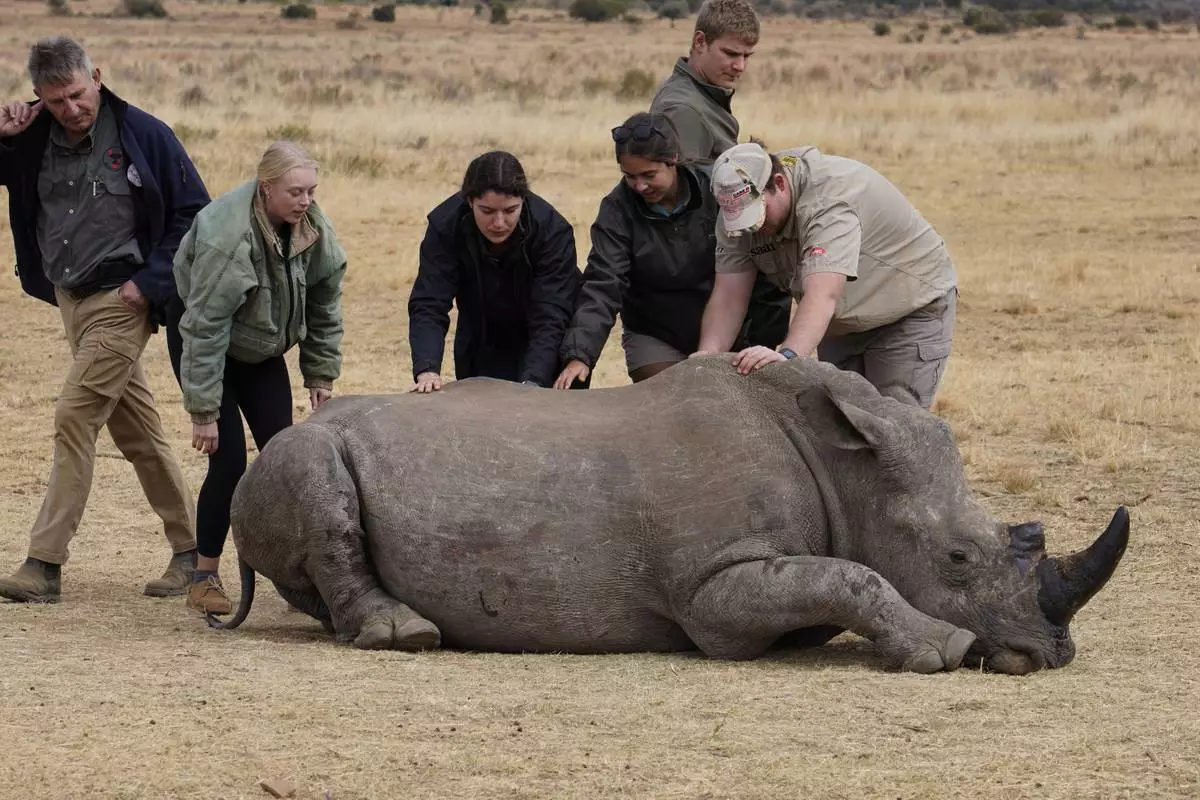
A sedated rhino is prepared to be tranquilized, before a hole is drilled into its horn and isotopes carefully inserted, at a rhino orphanage in the country's northern province of Limpopo, Tuesday, June 25, 2024. Researchers have started the final phase of a research project aimed at reducing rhino poaching by inserting radioisotopes into rhino horns to devalue one of the most highly trafficked wildlife commodities. (AP Photo/Denis Farrell)
PARIS (AP) — Voters across mainland France began casting ballots Sunday in the first round of exceptional parliamentary election that could put France’s government in the hands of nationalist, far-right parties for the first time since the Nazi era.
The outcome of the two-round election, which will wrap up July 7, could impact European financial markets, Western support for Ukraine and how France’s nuclear arsenal and global military force are managed.
Many French voters are frustrated about inflation and economic concerns, as well as President Emmanuel Macron’s leadership, which they see as arrogant and out-of-touch with their lives. Marine Le Pen’s anti-immigration National Rally party has tapped and fueled that discontent, notably via online platforms like TikTok, and dominated all preelection opinion polls.
A new coalition on the left, the New Popular Front, is also posing a challenge to the pro-business Macron and his centrist alliance Together for the Republic.
There are 49.5 million registered voters who will choose 577 members of the National Assembly, France's lower house of parliament, during the two-round voting.
After a blitz campaign marred by rising hate speech, voting began early in France’s overseas territories, and polling stations opened in mainland France at 8 a.m. (0600 GMT) Sunday. The first polling projections are expected at 8 p.m. (1800 GMT), when the final polling stations close, and early official results are expected later Sunday night.
In the restive French Pacific territory of New Caledonia, polls already closed at 5 p.m. local time due to an 8 p.m.-to-6 a.m. curfew that authorities on the archipelago have extended until July 8.
Nine people died during a two-week-long unrest in New Caledonia, where the Indigenous Kanak people have long sought to break free from France, which first took the Pacific territory in 1853. Violence flared on May 13 in response to attempts by Macron’s government to amend the French Constitution and change voting lists in New Caledonia, which Kanaks feared would further marginalize them.
Voters in France’s other overseas territories from Saint-Pierre-et-Miquelon, Saint-Barthélemy, Saint-Martin, Guadeloupe, Martinique, Guyana, French Polynesia and those voting in offices opened by embassies and consular posts across the Americas cast their ballots on Saturday.
Macron called the early election after his party was trounced in the European Parliament election earlier in June by the National Rally, which has historic ties to racism and antisemitism and is hostile toward France’s Muslim community. It was an audacious gamble that French voters who were complacent about the European Union election would be jolted into turning out for moderate forces in a national election to keep the far right out of power.
Instead, preelection polls suggest that the National Rally is gaining support and has a chance at winning a parliamentary majority. In that scenario, Macron would be expected to name 28-year-old National Rally President Jordan Bardella as prime minister in an awkward power-sharing system known as "cohabitation."
While Macron has said he won’t step down before his presidential term expires in 2027, cohabitation would weaken him at home and on the world stage.
The results of the first round will give a picture of overall voter sentiment, but not necessarily of the overall makeup of the next National Assembly. Predictions are extremely difficult because of the complicated voting system, and because parties will work between the two rounds to make alliances in some constituencies or pull out of others.
In the past such tactical maneuvers helped keep far-right candidates from power. But now support for Le Pen's party has spread deep and wide.
Bardella, who has no governing experience, says he would use the powers of prime minister to stop Macron from continuing to supply long-range weapons to Ukraine for the war with Russia. His party has historical ties to Russia.
The party has also questioned the right to citizenship for people born in France, and wants to curtail the rights of French citizens with dual nationality. Critics say this undermines fundamental human rights and is a threat to France's democratic ideals.
Meanwhile, huge public spending promises by the National Rally and especially the left-wing coalition have shaken markets and ignited worries about France's heavy debt, already criticized by EU watchdogs.
Follow AP's coverage of elections at https://apnews.com/hub/global-elections
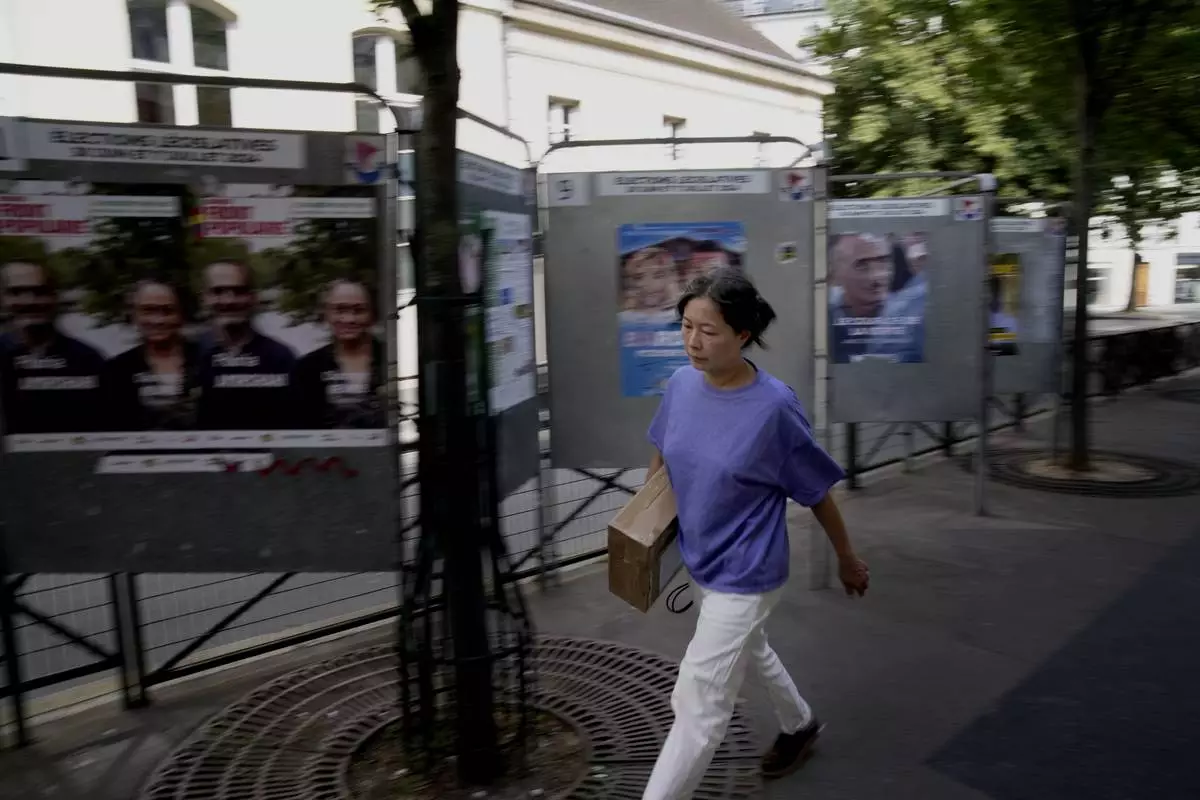
A woman walks past campaign boards for the upcoming parliamentary elections in Paris, Thursday June 27, 2024. Voters will choose lawmakers for the National Assembly in two rounds on June 30 and July 7. (AP Photo/Christophe Ena)

People gather on the Republique Plaza during a rally in Paris, Thursday June 27, 2024. Anti-racism groups joined French unions and left-wing coalition in protests against the surging nationalist far right as French President Emmanuel Macron called snap elections following the defeat of his centrist alliance at European Union elections earlier this month. (AP Photo/Christophe Ena)

FILE - Jordan Bardella, president of the far-right National Front party, arrives at the Eurosatory Defense and security exhibition, Wednesday, June 19, 2024 in Villepinte, north of Paris. The perspective of a defeat in parliamentary elections mean he may have to share power with a prime minister from rival political party — that could possibly be far-right National Rally's president Jordan Bardella. Macron defeated twice the National Rally's leader Marine Le Pen in the presidential election, both in 2017 and 2022.( AP Photo/Michel Euler, File)

FILE - French President Emmanuel Macron, right, meets French far-right Rassemblement National (National Rally) leader Marine Le Pen at the Elysee Palace on June 21, 2022 in Paris. The perspective of a defeat in parliamentary elections mean he may have to share power with a prime minister from rival political party — that could possibly be far-right National Rally's president Jordan Bardella. Macron defeated twice the National Rally's leader Marine Le Pen in the presidential election, both in 2017 and 2022. (Ludovic Marin/Pool photo via AP, File)











